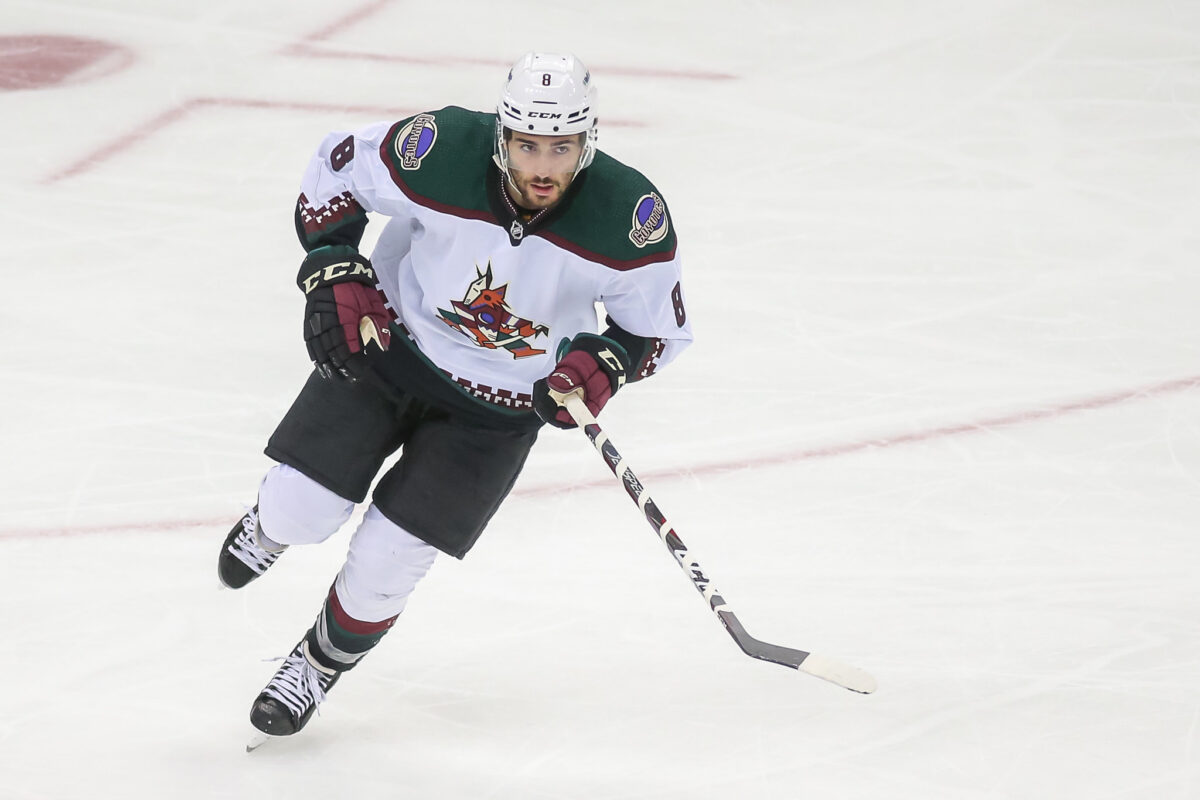The Colorado Avalanche are just over two weeks removed from their Game 7 loss to the Seattle Kraken in Round 1 of the 2023 NHL Playoffs, and around six weeks from the 2023 NHL Entry Draft and the start of the 2023 free agent period.
Long story short, the busiest stretch of the annual NHL offseason is rapidly approaching. The organization’s front office has several significant decisions to mull over, several of which could have ramifications on the next half-decade of Avalanche hockey.
However, of the Avalanche’s main offseason priorities, finally finding a permanent replacement for Nazem Kadri in the second-line center slot is arguably the most pressing. Despite the positional need, bolstering a depleted forward group at any position in general shouldn’t be avoided given how often the team found itself shorthanded during the season.
Assuming the Valeri Nichushkin situation is resolved and he returns next season, the Avalanche are slated to have around $62 million tied up in 12 players which leaves $20 million to fill out the rest of the roster. Any potential trade for a top-six forward likely requires that salary goes the other way.
Depending on who the Avalanche value most on the blue line (the organization’s source of talent surplus), Samuel Girard ($5 million average annual value – AAV), Josh Manson ($4.5 million AAV), or Devon Toews ($4.1 million AAV) are among the most realistic outgoing parties. They carry enough of a cap hit and trade value that a mutually beneficial deal could be orchestrated without sacrificing depth on defense.
That’s a discussion for another time but with that in mind, let’s dive into several potentially intriguing forward trade targets for the Avalanche this offseason.
William Nylander, Toronto Maple Leafs
In case you missed it, the Toronto Maple Leafs recently suffered another early postseason exit, this time at the hands of the Florida Panthers. Understandably, all eyes have turned to the franchise’s key decision makers, some of which either lack contracts for the 2023-24 season or are set to enter the final year of their contracts without an extension in hand.
While the Maple Leafs’ year-end press conference offered up a number of notable quotes in which no course of action was taken off of the table, it was an idea posited by someone unaffiliated with the organization that caused the biggest stir. NHL insider Jeff Marek, one-half of the sport’s most influential podcasts, threw out the Maple Leafs and the Avalanche as a pair of potential trade partners, with winger William Nylander the focus of his musings.
“If you make William Nylander available, I know a lot of Nylander haters won’t like to hear this, there will be a huge market for William Nylander…The one that keeps popping out to me when I think about if the Leafs want to go to market with Nylander is Colorado”…“You telling me the Avalanche, where [Gabriel] Landeskog is not playing next season and we have a whole bunch of questions about the future of [Valeri] Nichushkin, you’re telling me that couldn’t be a home for someone like Nylander and with their structure and with their leadership group?”
From 32 Thoughts: The Podcast, ‘No Canada’, 05/15/23
So, what’s driving such rumours? For starters, Nylander has one year remaining on his current contract and carries a very manageable cap hit of just under $7 million annually, particularly for a player coming off of a career-best 40-goal, 87-point campaign. Augmenting his attractiveness as a trade candidate is the fact that Nylander arguably performed the best of the Maple Leafs’ core players during the playoffs, tallying four goals and 10 points in 11 games.

According to Corey Sznajder’s tracking data, Nylander is one of the NHL’s top dual threats, ranking second among Maple Leafs forwards in shots and shot assists per-60-minutes at 5-on-5, ranking behind only Auston Matthews and Mitch Marner respectively. He is also one of the league’s most effective forwards at carrying the puck in transition, completing one of the highest rates of offensive zone entries with possession, and entries leading to a scoring chance.
Acquiring the 27-year-old winger would make the Avalanche even more dangerous off the rush, and inject creativity that was often absent beyond Nathan MacKinnon and Mikko Rantanen last season. His contract situation would need to promptly be resolved before any significant trade is consummated (what terms can Nylander command?), but a mutually beneficial deal in which both the Avalanche and Maple Leafs address weaknesses is possible.
Evgeny Kuznetsov, Washington Capitals
Next on the trade board is the Washington Capitals’ disgruntled center, 30-year-old Evgeny Kuznetsov. With rumours of a trade request coupled with reports that the Capitals were underwhelmed with his performance last season suggests he could be had at something of a discount, particularly as the organization looks to retool in advance of the post-Alexander Ovechkin era.
Kuznetsov’s current contract carries a $7.8 million AAV through the 2024-25 season, making both the cap hit and term fairly palatable for the Avalanche as they look for cost certainty in the immediate future. With captain Gabriel Landeskog being ruled out for the entirety of next season, his $7 million can be assigned to Long-Term Injured Reserve (LTIR) to create the requisite room to bring on the Russian pivot if the team is so inclined.
You may also like:
- Projected Lineups for Kings vs Avalanche – 12/29/25
- Avalanche Week Ahead: Schedule & Storylines – MacKinnon, Makar, Necas and More
- NHL Morning Recap – December 28, 2025
- Projected Lineups for Avalanche vs Golden Knights – 12/27/25
- NHL Rumors: Danault Talks, War Over O’Reilly, & a Bruins Target
While it’s true that Kuznetsov’s per-game offensive output declined this season and represented the lowest production rate of his career, a change of scenery could serve him well given the whispers around his intentions. He’s only a season removed from scoring 78 points in 79 games and tracking data still paints him as an effective puck carrier and as the Capitals’ most dangerous playmaker.
The Avalanche can surround and insulate Kuznetsov with tenacious forecheckers such as Nichushkin (assuming he returns) and Artturi Lehkonen who can disguise any defensive shortcomings. While the Avalanche may prefer a player closer to their peak of performance rather than on the wrong side of 30, Kuznetsov’s remaining term makes him an acceptable gamble.
Nick Schmaltz, Arizona Coyotes
Among a host of interesting trade candidates, the Arizona Coyotes’ Nick Schmaltz could be the best fit for the Avalanche, all things considered. Not only does he fit the Avalanche’s competitive timeline as a 27-year-old, but he can play across the forward line and carries an affordable cap hit ($5.85 million AAV) for another three seasons. Most importantly, his best seasons will come before the Coyotes can reap the rewards of his productivity.
Assuming the Coyotes continue their promising rebuild for the next two or three seasons, Schmaltz will be approaching age 30 and in need of a new contract at which point it becomes increasingly unlikely that he provides positive value on his next deal.
Further, Schmaltz’s actual salary owed takes a significant jump next season from the $4.5 million he earned in 2022-23, something that has prompted the Coyotes to trade players in the past. Over the final three seasons of his deal, he will be owed $7.5 million (2023-24), $8.45 million (2024-25), and $8.5 million (2025-26) as his contract was structured to be backloaded. The Avalanche could capitalize on the Coyotes’ aversion to paying more in real dollars while dangling some of their few remaining trade assets in the process.

Beyond the financial implications, Schmaltz is a dynamic forward coming off of a 58-point season (in 63 games) for a rebuilding squad with little in the way of offensive talent. He’s generated offense both off the rush and the cycle and possesses the offensive awareness to wriggle into dangerous areas and get on the end of attacking actions.
Using Corey Sznajder’s tracking data, the American forward is an elite transition player whose playmaking chops would be more highly regarded if he was surrounded by the quality of finishers found in the Avalanche lineup. He’s demonstrated the ability and confidence to collect the puck in his own zone and kickstart breakouts, though that wouldn’t be necessary with the Avalanche where the likes of MacKinnon and Cale Makar function as one-man breakout machines.
Looking at all the factors, Schmaltz would be my ideal trade target for the organization. He’s relatively young, has cost certainty at a fair price for a top-six forward, and could have his strengths amplified in a high-octane system where he doesn’t have to be the primary offensive driver. Of course, those characteristics likely make him one of the most attractive targets on the market this summer and the Avalanche will likely battle a number of aggressive suitors.
Avalanche Have Options to Bolster Forward Group
What is obvious is that, if they so choose, the Avalanche’s executive group are likely to have a number of intriguing forwards to target during the upcoming offseason. Although finding a permanent solution for the hole at second-line center should be the main priority, opting for a play-driving winger (like Nylander) could nudge the club towards opting for a less expensive, more subdued acquisition at center either via trade or free agency.
Ultimately, the executive group’s decision will come down to how they view their future on the back end and which, if any, of their core is expendable in the name of addressing a glaring weakness. There is a clear path back towards Stanley Cup contention for the Avalanche, but it’s up to Chris MacFarland and company to take the reins and set down the trail.
Honourable Mentions: Elias Lindholm (Calgary Flames); Mark Scheifele (Winnipeg Jets); Travis Konecny (Philadelphia Flyers); Adam Henrique (Anaheim Ducks); Boone Jenner (Columbus Blue Jackets)
Data courtesy of AllThreeZones and the NHL.
